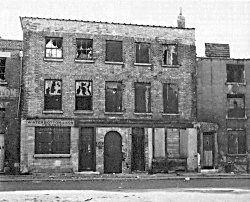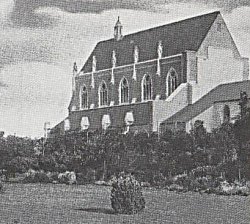
Prior to the Second Catholic Relief Act of 1791 it had been prohibited to build a Roman Catholic Church in a Borough which meant that Catholics in Portsmouth had to travel to Gosport or Havant where churches were permitted if they wished to attend Mass. The first acknowledged catholic priest in Portsmouth Borough was an Irishman, John Cahill and the first mission building was probably in Unicorn Row, Portsea and may have been no more than a private house. Cahill was succeeded by Rev Joseph Knapp in 1794 and in January 1796, a chapel was built at 25 Prince George Street, but all reports suggest it was a modest affair with access via a narrow passage between Nos. 25 and 26. Knapp remained until 1799 when he handed over to Thomas Gabb. The post then passed successively to Francis Delarue, John Welsh, Peter Perry, Ignatius Collingridge, George Evison, William Kelly and Henry Phillips who handed over to the last priest at Prince George Street, Reverend John Horan in 1865.

Horan was born on 7th January 1834 in Ireland and we know that he attended the seminary at Ware, that by 1857 he was at Woolwich and in 1861 he moved on to Chislehurst. Nothing else is known of his life before he arrived in Portsea, but for the remaining 20 years of his life he made a substantial impact on the town.
On being appointed, Reverend Horan surveyed his flock to find that they totalled less than 1000, excepting those occasions when an Irish regiment might be posted to the area when there would be an overwhelming increase in the numbers attending Mass. The Prince George Street Chapel had been extended before Horan's arrival but even so, was frequently too small to accommodate the congregation. This limit on space fuelled Horan's driving ambition to push the catholic faith to the forefront of religious life in Portsmouth, an aim that could only be achieved with a significant increase in the numbers attending church and consequently the building of a bigger church. This though was a long term project and in the meantime Reverend Horan had two further passions.
In the first he encouraged the use of music in the liturgy, and, being no singer himself, asked his Bishop to send him a priest who could sing. The Hampshire Telegraph reported on 5th May 1869 a Grand High Mass at the Chapel at which Horan allowed his priest Francis Kelleher to be celebrant whilst he himself performed the role of deacon. This was a particularly significant occasion in that several member of the Opera Company, then performing at the Theatre Royal gave their services in the singing of the mass (Mozart's No. 12). The service was concluded with Handel's Hallelujah Chorus.
Horan's second passion was that of the education of the poor and in this he was both following Catholic tradition and cementing that role in the future life of the extended community he could envisage. This ongoing process was augmented by Horan's determination to play a role on the School Board which was being established by the Borough Corporation in January 1871. From the outset it was considered proper that membership of the board should be representative of all the main religions in town, from the Anglicans to the Dissenters, including the Teetotallers and the Band of Hope. The Catholics were not mentioned in any of the press coverage of the election to the board and Horan's name did not crop up in the initial lists of the pre-eminent men seeking to serve on the board, and yet when the results of the election were declared on 18th January, Horan had the seventh highest number of votes and so joined a board made up almost entirely of religious men. He remained on the School Board for the rest of his life, being re-elected for the last time in 1882.
Neither his educational interests nor his general pastoral work could deflect Horan from his principle objective which was still the expansion of the faith in Portsmouth and specifically the building of a new, larger church. He was an enthusiastic fund raiser with many of his projects being reported by the local press. In particular he seemed fond of holding tea parties, usually at the Beneficial Hall in Kent Street but the majority of income was derived from the donations from individual members of the congregation, one mite at a time. Whilst these collections were going on Horan tackled the funding problem from the other direction and actively sought loans, principally from the Bishop of Southwark Diocese. There exist a collection of letters written by Horan advising his Bishop of the various plots of land he had selected as possible sites for the new church, comparing each in terms of size and value for money.

Eventually Reverend Horan found a site that was perfect. It was a triangular plot, bounded by Unicorn Road, Edinburgh Road and Alfred Road and was easily large enough to accommodate a sizable church together with several school buildings and housing for the clergy. It was an astonishing feat for Horan who had achieved the near miraculous from quite lowly origins in the space of little more than a decade. Buying the land was only the first step, more funds were needed to commission an architect and create the building itself, but Horan did not forget his priorities and the first buildings to be erected on site were those for a school.
At the same time as Reverend Horan was creating his new church the hierarchy of the catholic church in England was considering whether to split up the Diocese of Southwark which at that time was responsible for the whole of south and south-east England. Originally, a new diocese was to be carved out of the western half of Southwark and centred on Southampton, but the church there were not keen on the notion and so the new diocese took the name of Portsmouth. In May 1882 Cardinal Manning consecrated Dr. John Vertue as the first Catholic Bishop of Portsmouth and in August that year he opened the new Cathedral. John Horan became Administrator in the Cathedral, a post we would now refer to as Dean, and took the title of Canon.

No detailed accounts of Horan's work within the Cathedral have survived, but it is known that he continued his work on the School Board. Sadly Canon Horan did not live to see the completed Cathedral building; he died at his home on Victoria Road, Southsea on 21st August 1885 after a lengthy illness. He was buried on the 29th August in Highland Road Cemetery, an event recorded in lavish detail by the Hampshire Telegraph, which reported that the loss was deeply regretted not only "by members of his own community, but also from almost every religious creed in the borough. The high estimation in which the late Canon was held has already been referred to, and though one of the most unobtrusive of men his worth, now he is gone, becomes more and more apparent, and no more striking proof of the loving memory in which his labours were held, especially amongst the 'lesser blest with this world's goods,' could have been forthcoming than in the many aged poor who on Tuesday wended their way to the cemetery, many evidently at much physical fatigue, in order to pay a last tribute of respect to one who had laboured so long and earnestly amongst them."
By a quirk of history, Horan died very shortly after Highland Road Cemetery had been substantially extended to the south and was the first to be buried in a plot there that had been reserved for Catholics. That plot subsequently became known, and remains known to this day, as the Horan Division. A more traditional form of memorial, an elegant stone cross, was erected over the grave early in 1886 and a memorial window in the Cathedral was unveiled.
Tim Backhouse
June 2010
REFERENCES
The Hampshire Telegraph
"Diocese of Portsmouth - Past and Present" by Gerard Dwyer
"Rebirth of Roman Catholicism in Portsmouth" by Val Fontana (Portsmouth Paper No. 56)
Additional research by Tricia Lovell